discover
The University in Space
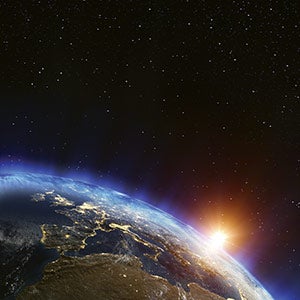
When the Hubble Space Telescope takes pictures of the universe, there's a Case Western Reserve professor who uses the images to search for new stars in nearby galaxies. When NASA sends a probe to orbit (and eventually crash into) Mercury, there's a Case Western Reserve researcher making sense of what it sees. When a rover digs into the surface of Mars, there's a university engineer who has done advance work to help keep its wheels rolling.
In a tradition older than NASA itself, university researchers have played a role in our understanding and exploration of the universe.
Not long after the launch of Sputnik, the Case Institute of Technology forged a special relationship with space science when, in 1958, its president, T. Keith Glennan, took a leave to lead NASA as its founding director. Before Glennan returned to Cleveland in 1961, the space agency had launched more than a dozen missions, selected the Project Mercury astronauts and laid the groundwork for the Apollo missions.
But even before Glennan, trailblazing work was taking place at what's now Case Western Reserve University—perhaps none more famous than the 1887 Michelson-Morley Experiment by Professors Albert A. Michelson and Edward Williams Morley. They proved that the aether, the hypothetical substance through which electromagnetic waves were thought to travel, did not exist—a finding reflected in Albert Einstein's Theory of Relativity. Michelson later became the first American scientist to win the Nobel Prize.
Waves still are part of the university's space-science work, which ranges from the plainly practical to the deeply theoretical, from the edges of the expanding universe to its tiniest graviton.
On the latter side are Associate Professor Andrew J. Tolley, PhD, and Assistant Professor Claudia de Rham, PhD, physicists who have hypothesized that the theoretical "graviton," the particle that carries gravity, has mass. If they're right, massive gravity could explain why the universe expands at an accelerating pace.
Ralph Harvey, PhD, a professor researching planetary materials, has pursued more solid quarry, making regular trips to Antarctica to scoop up some 22,000 meteorites to better understand the planets and is now working with NASA Glenn Research Center in Cleveland to simulate Venus and its poisonous atmosphere. He's also on a NASA Glenn project that, as he put it, is "trying to send a shoebox sized spacecraft to visit a house-sized asteroid." Harvey's role: to explain the scientific objectives of studying such a small asteroid and analyze the results.
And on the immediately practical end of things was a project last fall involving students from law, business, engineering, and arts and sciences in the graduate level Fusion program. They worked to help commercialize a water-purification technology developed at NASA Glenn. The purifier could be a boon, not only for long-distance space travel, but for water-purification challenges on Earth as well.
Case Western Reserve's space-related research extends both deep and wide. What follows is only a sample of the university's contributions to exploration.
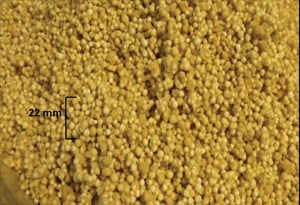 COURTESY OF XIANGWU "DAVID" ZENG
COURTESY OF XIANGWU "DAVID" ZENGTrue Grit
The research
In 2009, the Mars rover Spirit rolled into a small crater and stopped for good, its wheels spinning uselessly on the sandy surface. The work of Xiangwu "David" Zeng, PhD, the Frank H. Neff Professor and chair of the Department of Civil Engineering, could help prevent such a thing from happening again. Working with NASA Glenn, Zeng has simulated Martian dirt for NASA to use in the future to test rover wheels. "The No. 1 challenge is that the gravity on the surface of Mars is only a third of what we have on Earth," Zeng said. Tiny polystyrene foam spheres proved to be the magic ingredient in the soil mix.
The significance
Mars rovers are invaluable for planetary exploration. Zeng is a geotechnical adviser for Insight Mission, a Mars rover project that was to launch this past March, but now is scheduled for May 2018. He said NASA plans to test InSight's wheels on his soil—and if this rover sends back data, the engineer will learn how close his creation comes to the real thing.
 COURTESY OF NASA/ESA/K. KUNTZ/JHU/F. BRESOLIN/U. HAWAII/J. TRAUGER/JPL/J. MOULD/NOAO/Y.-H. CHU/U. ILLINOIS/STSCI
COURTESY OF NASA/ESA/K. KUNTZ/JHU/F. BRESOLIN/U. HAWAII/J. TRAUGER/JPL/J. MOULD/NOAO/Y.-H. CHU/U. ILLINOIS/STSCIBlue Light Special
The research
When Astronomy Professor Chris Mihos, PhD, looked at images captured in 2009-10 with the university's telescope at the Kitt Peak National Observatory in Arizona, he saw a plume of blue light at the ragged edge of the M101 galaxy 25 million light years away. Mihos suspected the light came from a smattering of young stars, possibly born in a collision with a neighboring galaxy about 200 million years ago. Last fall, his team took a closer look, free from the interfering effects of Earth's atmosphere, from the Hubble Space Telescope. By January, the evidence was clear: They were seeing baby stars.
The significance
The observations reveal fundamental information on how galaxies work. "We're finding the young stars," Mihos said, noting the observations fit the predictions of their models of galaxy behavior. "We're finding them in the right places, in the right number and at roughly the right ages. We're really excited about this."
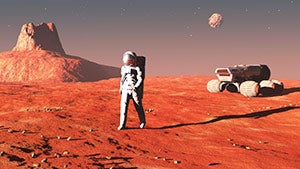
Cosmic Rays and Space Travel
The research
When astronauts voyage beyond Earth's atmosphere, they're bombarded by particles, traveling at near light speed, called galactic cosmic radiation. Stanton Gerson, MD, director of the Case Comprehensive Cancer Center, and Scott Welford, PhD, assistant professor of radiation oncology, hope to determine whether the stem cells that make blood components are irreparably weakened in the cosmic onslaught of these particles—nuclei stripped of their electrons. Astronauts may be particularly vulnerable because most are older than 45, around the time most of us lose a critical DNA repair gene. The researchers hope to learn how well middle-aged stem cells function on a long flight by dosing mice missing the same gene with cosmic radiation generated at a laboratory on Earth.
The significance
The research may suggest ways to counter the effects of cosmic rays on astronauts traveling to other planets. "On the way to Mars, every cell in your body will be hit with an atom of heavy iron," Welford said. "That damage is complex to repair, if it can be repaired at all."
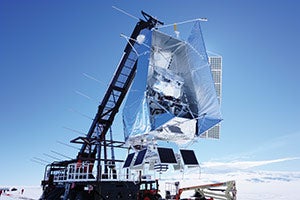 COURTESY OF BARTH NETTERFIELD
COURTESY OF BARTH NETTERFIELDA Message in Gravity Waves
The research
In less than an instant after the Big Bang 13.8 billion years ago, cosmologists believe the infant universe experienced a rapid growth spurt, known today as cosmic inflation. Last year, John Ruhl, PhD, the Connecticut Professor who specializes in physics and astronomy, along with collaborators in the United States and Canada, launched a football-field-sized balloon towing six telescopes to look for the signature of this inflationary event. The craft, known as SPIDER, spent the next 16 days floating 22 miles above Antarctica looking for signs of gravitational waves in the cosmic microwave background, the afterglow from the Big Bang.
The significance
If researchers can find and calibrate the strength of the waves, they'll learn something about what drove this inflationary period. "Others are doing similar science from the ground, but with a balloon 20 miles above Antarctica, we have less noise from the atmosphere, giving us a clearer view," Ruhl said.
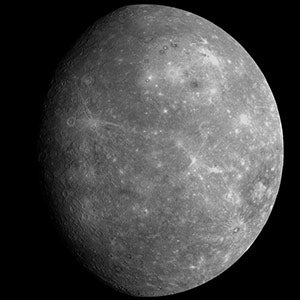 COURTESY OF NASA/JOHNS HOPKINS UNIVERSITY APPLIED PHYSICS LABORATORY/CARNEGIE INSTITUTION OF WASHINGTON
COURTESY OF NASA/JOHNS HOPKINS UNIVERSITY APPLIED PHYSICS LABORATORY/CARNEGIE INSTITUTION OF WASHINGTONCooling-Off Period
The research
Steven A. Hauck II, PhD, professor of planetary geodynamics, is uncovering secrets of Mercury, the little planet closest to the sun, with the help of NASA's MESSENGER spacecraft. MESSENGER crashed into Mercury in April 2015, but the information it gathered during its four years in orbit solved several mysteries about the planet's evolution. For instance, Hauck learned that Mercury's rocky outer layer is a third thinner than originally believed. Given that in thin rocky layers the motions and transfer of heat are less efficient than in thicker ones, this finding helps explain why Mercury's core is still molten. Another discovery by Hauck and colleagues around the country: Mercury is shrinking. Its radius is 4 miles smaller than it was 4 billion years ago.
The significance
Findings could help tell the story of how the rocky planets—Mercury, Venus, Earth and Mars— evolved. What drives a planet's geologic development is the loss of heat from the interior. "Everything that happens stems from heat trying to get out into space."
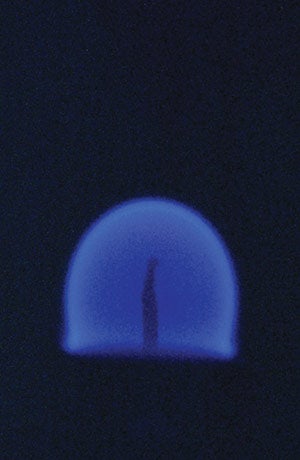 COURTESY OF NASA GLENN RESEARCH CENTER
COURTESY OF NASA GLENN RESEARCH CENTERGreat Spheres of Fire
The research
In a vehicle racing through space, the possibility of fire is unthinkable. Yet it's difficult to know what materials will be fireproof in reduced or zero gravity—or how to find out, said James T'ien, PhD, the Leonard Case Jr. Professor of Engineering. Scientists know a candle will burn as a blue sphere without gravity's pull, but they don't know how intense a fire can become. T'ien and Ya-Ting Liao, PhD, an assistant professor in engineering, are on a team that worked with NASA Glenn on three fire experiments. The first launched in March on an unmanned Cygnus resupply craft sent to the International Space Station. The automated flame experiment—known as NASA's Spacecraft Fire Experiment, or Saffire—will occur inside an onboard box after Cygnus leaves the station.
The significance
Scientists will learn how fire behaves in microgravity, which could be used to test materials on Earth. "We have to find a methodology to connect the performance of our flammability tests in normal gravity to the performance of materials in zero gravity," T'ien said.
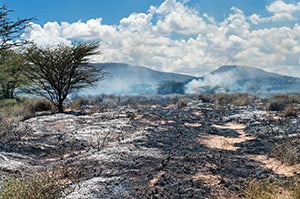
Breathing Fire
The research
Other faculty members work with NASA to save firefighters on Earth. Fumiaki Takahashi, PhD, professor of mechanical and aerospace engineering, has teamed with NASA and an engineering firm to develop a prototype monitor for firefighters. They're modifying International Space Station sensors to detect other dangerous chemicals, such as formaldehyde and acrolein—toxic even at tiny concentrations. The prototypes will be tested in university labs and in the field with municipal and forest firefighters.
The significance
The sensors that firefighters now use test for carbon monoxide, but when that dissipates after a fire, other toxic elements remain, endangering firefighters. "Toxic gases and ultrafine smoke particles are invisible to the naked eye and contain carcinogens," Takahashi said. "The new device will alert firefighters to the danger of toxic environments in real time."
.jpg) COURTESY OF CASE ROCKET TEAM
COURTESY OF CASE ROCKET TEAMGaining Altitude
The research
Some 30 undergraduates are learning how to shepherd an experiment from notion to 10,000 feet as members of the Case Rocket Team. Allyson Beach, president of the group, said members spend fall semester building their own rockets to earn certification from the National Association of Rocketry. In the spring, they work as a group creating more sophisticated high-power rockets for competition. One of the rockets has to reach 10,000 feet. The group includes majors in engineering, aerospace, physics and biomedical engineering.
The significance
Nothing beats hands-on experience, whether a student intends to make rockets for a living or someday lead a team or start a business. "The most important lesson I learned is to be adaptable," said Beach, a senior majoring in aerospace and mechanical engineering. "Things come up all the time that you don't expect, all kinds of crazy things. Even if it's a bad thing, you can turn it into something good."





